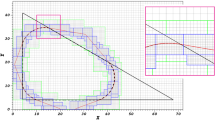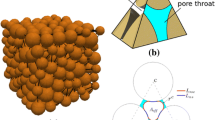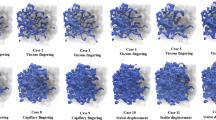Abstract
Displacement simulation in realistic pore networks, such as those derived from X-ray microtomography, is presented for the regime where capillarity controls fluid motions and spatial distributions. Complex displacement sequences involving both imbibition and drainage are constructed to extract wettability indices. The percolation properties of predicted equilibrium phase distributions are analyzed. Equilibrium fluid distributions are used to model transport properties for each phase.
Similar content being viewed by others
References
Fatt, I.: 1956, The network model of porous media, I. Capillary pressure characteristics,Petroleum Trans. AIME 207, 144–159.
Mohanty, K. and Salter, S.: 1982, Multiphase flow in porous media, I. Pore-level modeling, SPE paper 11018, Proc. 57th Annual Fall Technical Conf. and Exhibition Soc. Petroleum Engineers of AIME, New Orleans, September 26–29.
Lin, C -Y. and Slattery, J. C.: 1982, Three-dimensional, randomized, network model for two-phase flow through porous media,AIChE J. 28 (2), 311–324.
Dias, M. M. and Payatakes, A. C.: 1986, Network models for two-phase flow in porous media, Part 1. Immiscible microdisplacement of non-wetting fluids,J. Fluid Mech. 164, 305–336.
McDougall, S. R. and Sorbie, K. S.: 1992, Network simulations of flow processes in strongly wetted and mixed-wet porous media,Proc. 3rd European Conf. Mathematics of Oil Recovery, Delft, June 17–19, pp. 169–181.
Dunsmuir, J. H., Ferguson, S. R., D'Amico, K. L. and Stokes, J. P.: 1991, X-ray microtomography: A new tool for the characterization of porous media, SPE paper 22860, Proc. 66th Annual Technical Conf. and Exhibition Soc. Petroleum Engineers, Dallas, October 6–9.
Jasti, J., Jesion, G., and Feldkamp, L.: 1990, Microscopic imaging of porous media using X-ray computer tomography, SPE Paper 20495, Proc. 65th Annual Technical Conf. and Exhibition of the Soc. Petroleum Engineers, New Orleans, September 23–26.
Coles, M. E., Spanne, P., Muegge, E. L. and Jones, K.: 1994, Computed microtomography of reservoir core samples, Proc. Int. Symp. Soc. Core Analysts, Stavanger, September 12–14.
Adler, P. M., Jacquin, C. G. and Quibler, J. A.: 1990, Flow in simulated porous media,Int. J. Multiphase Flow 16 (4), 691–712.
Adler, P. M., 1992,Porous Media: Geometry and Transports, Butterworth/Heinemann, Stoneham, MA.
Spanne, P., Thovert, J. F., Jacquin, C. J., Lindquist, W. B., Jones, K. W. and Adler, P. M.: 1994, Synchrotron computed microtomography of porous media: Topology and transports,Phys. Rev. Lett. 73 (14), 2001–2004.
Anderson, W. G.: 1986, Wettability literature survey, Part 2: Wettability measurement,J. Petroleum Technol. November, 1246–1262.
Hazlett, R. D.: 1990, Fractal applications: Wettability and contact angle,J. Colloid Interface Sci. 137 (2), 527–533.
Hazlett, R. D.: 1992, On surface roughness effects in wetting phenomena,J. Adhesion Sci. Technol. 6 (6), 625–633.
Fassi-Fihri, O. and Robin, M. and Rosenberg, E.: 1991, Wettability studies at the pore level: A new approach by the use of cryo-scanning electron microscopy, SPE paper 22596, Proc. 66th Annual Technical Conf. and Exhibition Soc. Petroleum Engineers, Dallas, October 6–9, 97–110.
Melrose, J. C.: 1982, Interpretation of mixed wettability states in reservoir rocks, SPE paper 10971, Proc. 57th Annual Fall Technical Conf. and Exhibition Soc. Petroleum Engineers of AIME, New Orleans, September 26–29.
Blunt, M., King, M. and Scher, H.: 1992, Simulation and theory of two-phase flow in porous media,Phys. Rev. A 46 (12), 7680–7699.
Adamson, A. W.: 1967,Physical Chemistry of Surfaces, Interscience, New York, pp. 548–549.
Jadhunandan, P. P.: 1990, Effects of brine composition, crude oil, and aging conditions on Wettability and oil recovery, Ph. D. Thesis, New Mexico Institute of Mining and Technology.
Shante, V. K. S. and Kirkpatrick, S.: 1971, An introduction to percolation theory,Adv. in Phys. 20, 325–357.
Essam, J. W.: 1980, Percolation theory,Rep. Prog. Phys. 43, 833–912.
Stauffer, D., Scaling theory of percolation clusters,Phys. Rep. 54 (1), 1–74.
Chandler, R., Koplik, J., Lerman, K. and Willemsen: 1982, Capillary displacement and percolation in porous media,J. Fluid Mech. 119, 249–267.
Grunau, D., Chen, S. and Eggert, K.: 1993, A lattice Boltzmann model for multiphase fluid flows,Phys. Fluids A 5 (10), 2557–2562.
Author information
Authors and Affiliations
Rights and permissions
About this article
Cite this article
Hazlett, R.D. Simulation of capillary-dominated displacements in microtomographic images of reservoir rocks. Transp Porous Med 20, 21–35 (1995). https://doi.org/10.1007/BF00616924
Received:
Issue Date:
DOI: https://doi.org/10.1007/BF00616924




